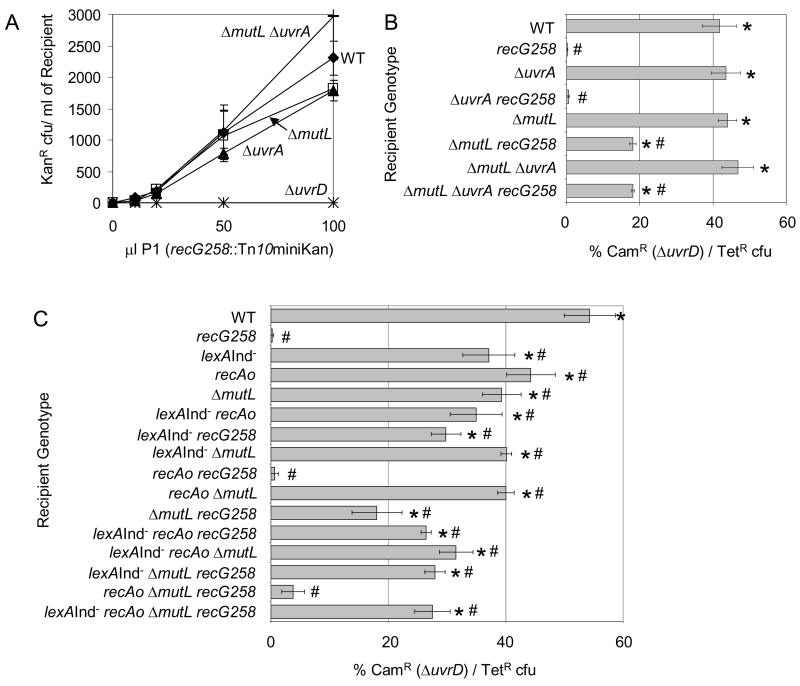Fig. 3.
Incomplete mismatch repair and not nucleotide excision repair contributes to death of recG ΔuvrD cells. (A) Simple loss of either MMR or NER does not cause inviability of recG cells, in that quantitative transduction of recG258 (SMR9932 donor) into strains mutant for proteins involved in NER (ΔuvrA, SMR8977), MMR (ΔmutL, SMR8982) or both (ΔuvrA ΔmutL, SMR8986) is not impaired relative to MMR- and NER-proficient cells (SMR6319). Therefore, blocking formation of the MMR and NER intermediates created by MutL and UvrA does not create an inviability with recG. ΔuvrD negative control, SMR8976. (B) Although simple loss of either MMR or NER does not cause inviability of recG cells, loss of the MutL step in MMR relieves some of the inviability of recG ΔuvrD cultures. This implies that MMR intermediates initiated by MutL can be lethal to recG cells if UvrD is not present to complete repair and remove those intermediates. ΔuvrD can be cotransduced with intermediate efficiency into a ΔmutL recG258 recipient (SMR11116) indicating a partial requirement for MutL, but not UvrA, in the death of recG ΔuvrD cultures. recG258 SMR10419; ΔuvrA recG258 SMR11115; MMR- and NER-proficient cells SMR6319 (“WT”); ΔuvrA SMR8977; ΔmutL SMR8982; ΔuvrA ΔmutL SMR8986; and ΔmutL ΔuvrA recG258 SMR11117 recipient cells. (C) The combination of incomplete MMR and SOS-induction does not account for all of the recG ΔuvrD inviability. When combined, the partial requirement for MutL and the SOS response does not restore more viability to recG ΔuvrD cells than lexA(Ind−) or ΔmutL alone, or in the presence of SOS-induced levels of RecA. MMR- and SOS-proficient cells SMR6319; recG258 SMR10419; lexA(Ind−) SMR9801; recAo281 SMR9809; ΔmutL SMR11323; lexA(Ind−) recAo281 SMR9805; lexA(Ind−) recG258 SMR10440; lexA(Ind−) ΔmutL SMR11318; recAo281 recG258 SMR10442; recAo281 ΔmutL SMR11320; ΔmutL recG258 SMR11116; lexA(Ind−) recAo281 recG258 SMR10441; lexA(Ind−) recAo281 ΔmutL SMR11319; lexA(Ind−) ΔmutL recG258 SMR11325; recAo281 ΔmutL recG258 SMR11329; lexA(Ind−) recAo281 ΔmutL recG258 SMR11327. Mean ± SEM of 3 experiments (A–C). * indicates a significant difference from recG; # indicates a significant difference from WT (B, C). In (B) the triple ΔmutL ΔuvrA recG258 mutant is significantly different from all of the constituent single and double mutants except for ΔmutL recG258 (p= 0.99). In (C) the quadruple mutant lexA(Ind−) recAo281 ΔmutL recG258 is significantly different from recAo281; lexA(Ind−) ΔmutL; recAo281 recG258; recAo281 ΔmutL (p= 0.01); ΔmutL (p= 0.02), and recAo281 ΔmutL recG258. For WT compared to recAo, p= 0.02.

